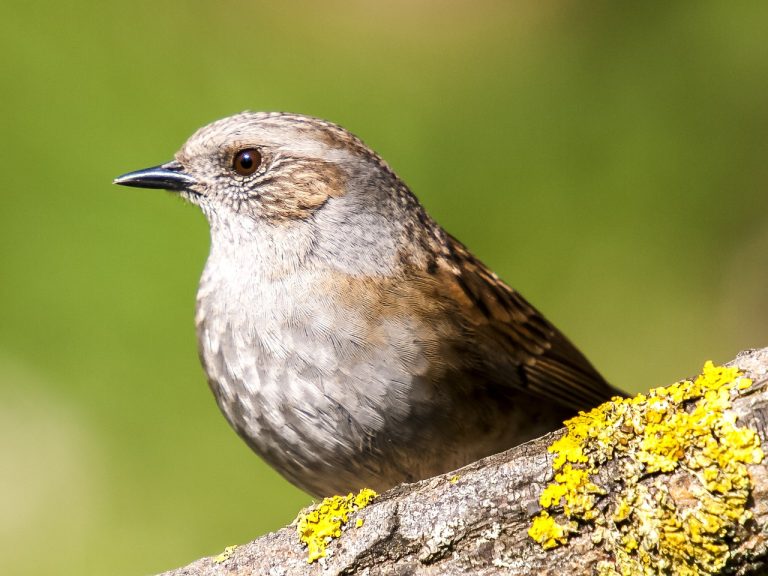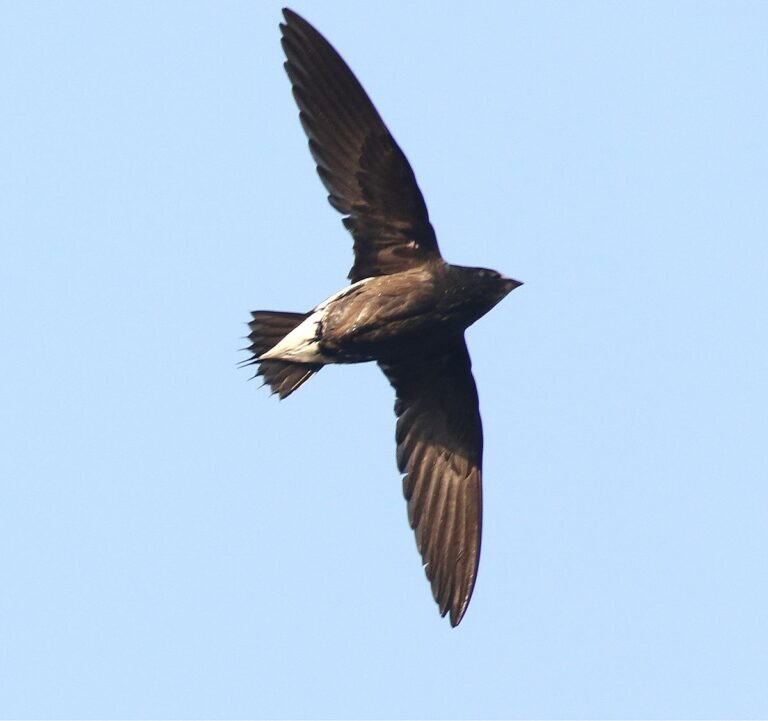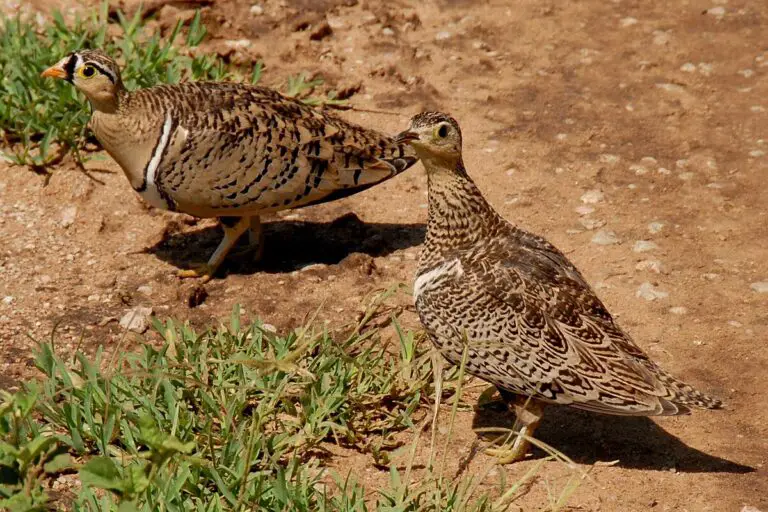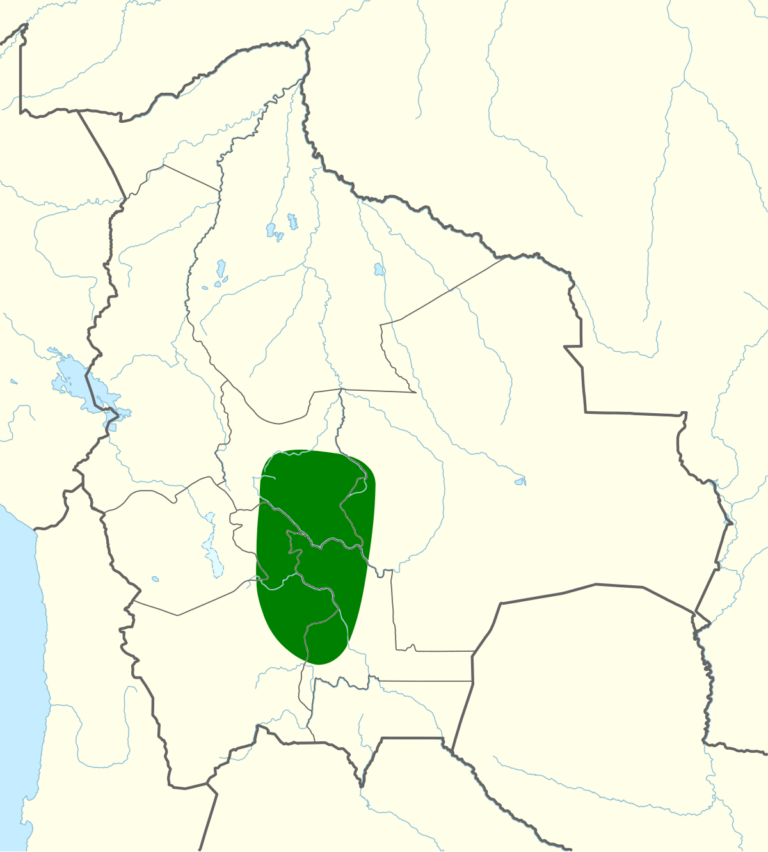Orange-Crowned Warbler (Leiothlypis celata)
Scientific Classification
[table id=8 /]
“Often mistaken for the Tennessee Warblers, which are equally dull.”
The Orange-crowned Warbler, scientifically classified as Leiothlypis celata, belongs to the following taxonomical hierarchy:
In terms of conservation status, the Orange-crowned Warbler is classified as “Least Concern” by the International Union for Conservation of Nature (IUCN). This suggests that the species is not currently facing any major threats to its survival.
Orange-crowned Warblers are primarily found in North America and Central America. Their range extends from parts of Canada down to Mexico and Central America. They inhabit various types of wooded habitats, including forests, woodlands, and shrubby areas.
Here’s a compilation of facts about the Orange-crowned Warbler:
Common Name: Orange-crowned Warbler
Scientific Name: Leiothlypis celata
Number of Species: 1
Location: Orange-crowned Warblers can be found in various regions including the United States, Bahamas, Belize, Canada, Costa Rica, El Salvador, Guatemala, Mexico, Saint Pierre and Miquelon, and Turks and Caicos Islands.
Habitat: They primarily inhabit forests.
Migratory: Yes
Nesting Location: They nest on the ground, in scrub oak, and riverside willows.
Prey: Their diet consists mainly of insects, as they are omnivores.
Predators: Predators include domestic and wild cats, as well as birds of prey such as hawks and eagles.
Fun Fact: Orange-crowned Warblers are often mistaken for Tennessee Warblers due to their similar appearance.
Estimated Population Size: Approximately 76 million
Biggest Threat: Global warming and urbanization pose significant threats to their population.
Most Distinctive Feature: Their yellow or dusky undertail
Physical Characteristics:
- Color: Yellow, black, and olive
- Skin Type: Feathers
- Top Speed: 25 mph
- Lifespan: 6 – 8 years
- Weight: 9 grams
- Length: 4.8 – 5.3 inches
Reproduction:
- Incubation Period: 12 days
- Litter Size: Typically 3-6 chicks
These facts provide a comprehensive overview of the Orange-crowned Warbler’s characteristics, behavior, and habitat.
Orange-crowned Warblers indeed possess distinct characteristics that make them unique among songbirds in the western hemisphere. Their high-pitched trill adds to their charm, and the variation in songs among males helps in distinguishing individuals.
In terms of parental care, it’s interesting that both parents participate in raising their young, a behavior not uncommon among birds. However, it’s noteworthy that only the mother is responsible for the incubation of eggs, which lasts for just under two weeks. This division of labor is a common strategy in bird species, where each parent contributes to different aspects of the reproductive process to ensure the survival of their offspring.
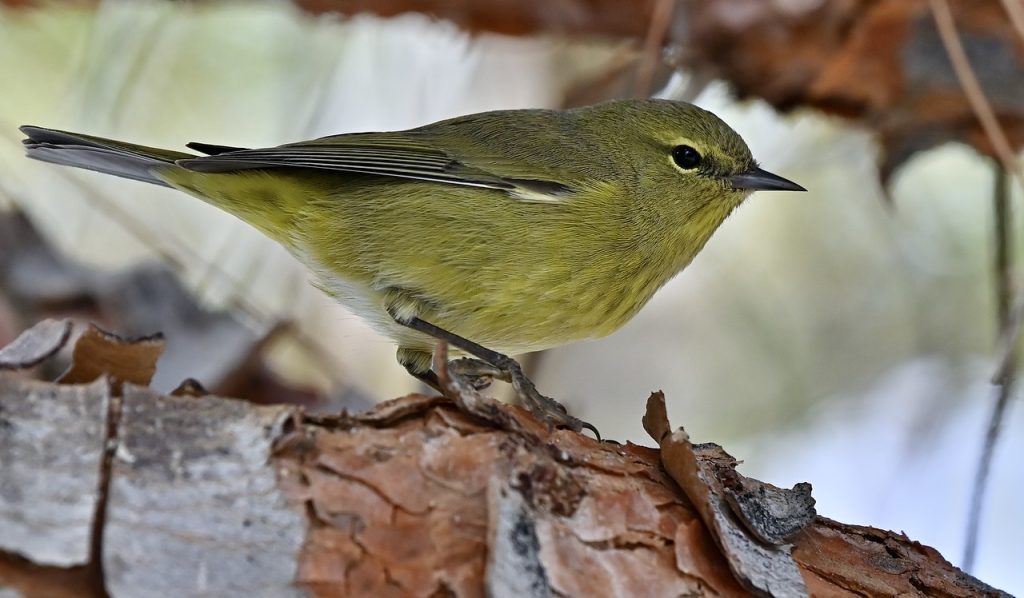
Orange-Crowned Warbler Amazing Facts
These additional facts about the Orange-crowned Warbler shed more light on their fascinating behavior and characteristics:
- Collective Nouns: A group of warblers, including the Orange-crowned Warbler, can be referred to as a “wrench,” “fall,” “confusion,” or “bouquet.” These terms reflect the diverse and sometimes whimsical nature of collective nouns used for groups of birds.
- Color Perception: Despite the inclusion of the word “orange” in their name, it’s challenging to see this color on Orange-crowned Warblers unless they are in an excited state. This highlights the subtle nuances of coloration in birds and the importance of observing them closely to appreciate their full beauty.
- Breeding Ground Stay: Orange-crowned Warblers exhibit flexibility in their behavior based on environmental conditions. If they find abundant food and sufficient warmth on their breeding grounds, they are likely to prolong their stay there. This adaptation demonstrates their ability to respond to resource availability and climatic factors to optimize their breeding success.
Where to Find Orange-Crowned Warblers
Spotting an Orange-crowned Warbler requires a keen eye and ear, as they tend to forage in shrubs and are more commonly found in certain regions during specific times of the year. Here’s a summary of their habitat preferences and nesting habits:
Habitat and Distribution:
- Orange-crowned Warblers are not commonly found in the western part of the United States but can be spotted in the southeastern region, especially during late spring and late fall (October).
- They are most frequently seen in areas with thickets, rivers, and shrubs, often on the edges of forests.
- Their range extends from North to South America, including countries like the Bahamas, Belize, Canada, Costa Rica, El Salvador, Guatemala, Mexico, Saint Pierre and Miquelon, and the Turks and Caicos Islands.
Foraging Behavior:
- They typically forage in shrubs, which is why observers may need to look down to spot them.
Vocalization:
- Their high-pitched and sharp calls are commonly heard, described by some as a trill that starts high and loud and descends towards the end of each note.
Nesting Habits:
- To avoid nest predation by other birds, most Orange-crowned Warblers build their nests on the ground, in tall shrubs, or low trees.
- The sordida subspecies is an exception to this nesting behavior.
- The only significant threat to their nests, apart from other birds, is the Island Scrub-Jay, which is endemic to Santa Cruz Island in California.
Understanding these habitat preferences and nesting habits can improve the chances of spotting or hearing an Orange-crowned Warbler in the wild.
The nesting behavior of female Orange-crowned Warblers involves careful selection of a concealed location with nearby vegetation to protect their nests from potential predators. Here are some key points about their nesting process:
- Nest Construction: The nest is typically constructed using a combination of leaves, twigs, grass, and moss, providing a sturdy and camouflaged structure for incubating eggs and raising young.
- Nest Lining: To provide warmth and cushioning for the eggs, the nest is lined with materials such as animal fur and dry grass, creating a cozy environment for the developing embryos.
- Parental Roles: Building the nest is a task undertaken solely by the female, demonstrating her role in providing a suitable environment for reproduction. However, the male remains nearby to stand guard and protect the nesting area from potential threats.
- Collaborative Effort: While nest construction is primarily the responsibility of the female, the male’s presence and vigilance contribute to the overall safety and success of the nesting process. This collaborative effort reflects the cooperative nature of parental care in many bird species.
By selecting concealed locations and constructing well-camouflaged nests, female Orange-crowned Warblers maximize the chances of successfully raising their young while minimizing the risk of predation.
Orange-Crowned Warbler Scientific Name
The history of the Orange-crowned Warbler’s scientific name reveals an interesting journey in taxonomy. Originally described as Sylvia celatus by American zoologist Thomas Say in 1822, the bird underwent a name change in 2008 by Dutch ornithologist George Sangster. The current scientific name, Leiothlypis celata, reflects this revision.
The species comprises four subspecies, each exhibiting variations in size, molt pattern, and plumage color:
- L. c. celata
- L. c. lutescens
- L. c. orestera
- L. c. sordida
The Latin word “celata,” from which the specific epithet “celata” is derived, translates to “secret” or “hidden.” This choice of name perhaps alludes to the bird’s often inconspicuous appearance and its preference for concealed habitats.
The renaming of species, along with the delineation of subspecies, reflects ongoing efforts in ornithology to refine and clarify taxonomic classifications based on new research and understanding of evolutionary relationships.
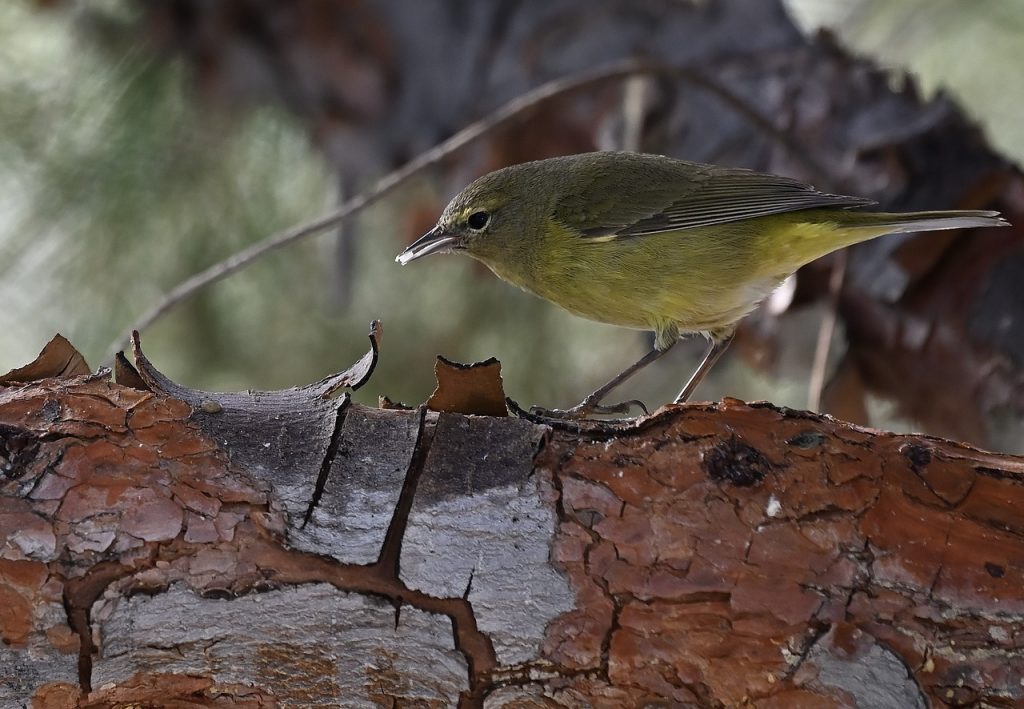
Orange-Crowned Warbler Appearance
The Orange-crowned Warbler’s appearance may not be as flamboyant as some other birds, but it possesses its own subtle beauty and unique features. Here’s a closer look at its physical characteristics:
- Coloration: While the name suggests a vibrant orange crown, this feature is typically only visible when the bird is excited, with its head feathers raised. Otherwise, the bird appears muted, ranging from gray to olive-green. The contrast in coloration varies among subspecies, with the dullest being L. c. celata and the brightest yellow seen on the Pacific Coast orange-crowned warbler. The L. c. sordida subspecies sports dark green feathers.
- Body Size: Orange-crowned Warblers are relatively small and lightweight. They weigh around 9 grams and measure just over 5 inches in length. Their slim bodies contribute to their agility and maneuverability in their habitat.
- Bill and Undertail Coverts: They have a sleek bill adapted for capturing insects, their primary food source. Warm yellow feathers adorn the undersides of their tails, adding a touch of color to their otherwise subtle appearance.
- Wing Features: A distinctive feature of the Orange-crowned Warbler is the absence of wing bars across their 7.25-inch wingspan. This characteristic helps differentiate them from other warbler species.
While they may not boast the striking colors of some birds, Orange-crowned Warblers are well-adapted to their environment and possess subtle characteristics that make them fascinating to observe in their natural habitat.
Orange-Crowned Warbler Behavior
The Orange-crowned Warbler’s song is indeed a remarkable aspect of its behavior and communication. Here’s a closer look at this distinctive feature:
- Varied Song: Unlike many other wood warblers that stick to a relatively small repertoire of melodies, the Orange-crowned Warbler’s song is highly varied. Notably, the call of each male can differ from that of others, creating a unique signature that helps in mate selection. This diversity in songs enhances the bird’s ability to communicate and establishes its individual identity among potential mates.
- Social Behavior: Orange-crowned Warblers may form “song neighborhoods,” comprising two to six males. Within these groups, individuals mimic each other’s songs, creating a dynamic and interactive environment. These groups often persist for years, demonstrating the long-term social bonds that can form among individuals of this species.
- Flight Speed: In addition to their impressive vocal abilities, Orange-crowned Warblers are also known for their fast and agile flight. This agility allows them to swiftly navigate through their habitat and catch prey, primarily insects, with ease. Their ability to maneuver quickly in flight enhances their foraging efficiency and survival in their environment.
By combining their diverse vocal repertoire with agile flight capabilities, Orange-crowned Warblers exhibit remarkable adaptability and social complexity, contributing to their success as songbirds in their habitat.
Orange-Crowned Warbler Migration Pattern and Timing
The migratory behavior of Orange-crowned Warblers is fascinating and reflects their adaptability to changing environmental conditions. Here are some key points about their migration:
- Early Migration: Orange-crowned Warblers initiate their migration in the spring, often earlier than many other bird species. This early start allows them to take advantage of favorable conditions for breeding and foraging.
- Extended Stay on Breeding Grounds: Unlike some migratory birds that have relatively short breeding seasons, Orange-crowned Warblers tend to prolong their stay on their breeding grounds. This behavior is likely influenced by the availability of food and the need to ensure successful reproduction.
- Northern Range: During migration, Orange-crowned Warblers are known to venture into northern Canada, a range that exceeds the typical migration routes of many other warbler species. This broader range reflects their adaptability and willingness to explore new territories in search of suitable habitats and food sources.
- Migration Drivers: The timing and extent of Orange-crowned Warblers’ migration are primarily determined by the availability of food and temperature conditions. As temperatures drop and food becomes scarce in northern regions, they undertake the journey southward to warmer climates where resources are more abundant.
- Destination: Their migration route takes them to Mexico and further south into Central America, where they can find favorable conditions for wintering. This cyclical movement between breeding and wintering grounds ensures their survival by exploiting resources across different geographic regions.
The migratory behavior of Orange-crowned Warblers underscores their adaptability and resourcefulness in responding to seasonal changes and environmental cues.
Orange-Crowned Warbler Diet
The Orange-crowned Warbler’s habitat preferences are closely linked to food availability, as they forage extensively for a variety of food sources. Here’s more information about their diet and foraging behavior:
- Diet: Orange-crowned Warblers are primarily insectivorous, feeding on a wide range of insects and their larvae found within their habitat. This includes beetles, caterpillars, flies, spiders, and other small invertebrates. They are opportunistic feeders and will consume whatever insects are abundant and accessible.
- Additional Food Sources: In addition to insects, Orange-crowned Warblers also supplement their diet with other food items such as nectar, berries, fruits, flowers, and occasionally seeds. This dietary flexibility allows them to exploit a diverse range of food resources throughout the year.
- Foraging Behavior: When foraging, Orange-crowned Warblers typically move from perch to perch, scanning the surrounding vegetation and ground for prey. While they primarily forage close to the ground, they may also feed higher up in shrubs and trees, especially when targeting berries or nectar from flowers.
- Attractants: If you’re interested in attracting Orange-crowned Warblers to your yard, providing suitable food sources can be effective. They are attracted to bird feeders containing sugar water (for nectar), suet, and peanut butter, especially during periods of food scarcity or when natural food sources are limited.
By understanding the Orange-crowned Warbler’s dietary preferences and foraging behavior, bird enthusiasts can create inviting habitats and provide supplemental food sources to attract and support these beautiful songbirds.
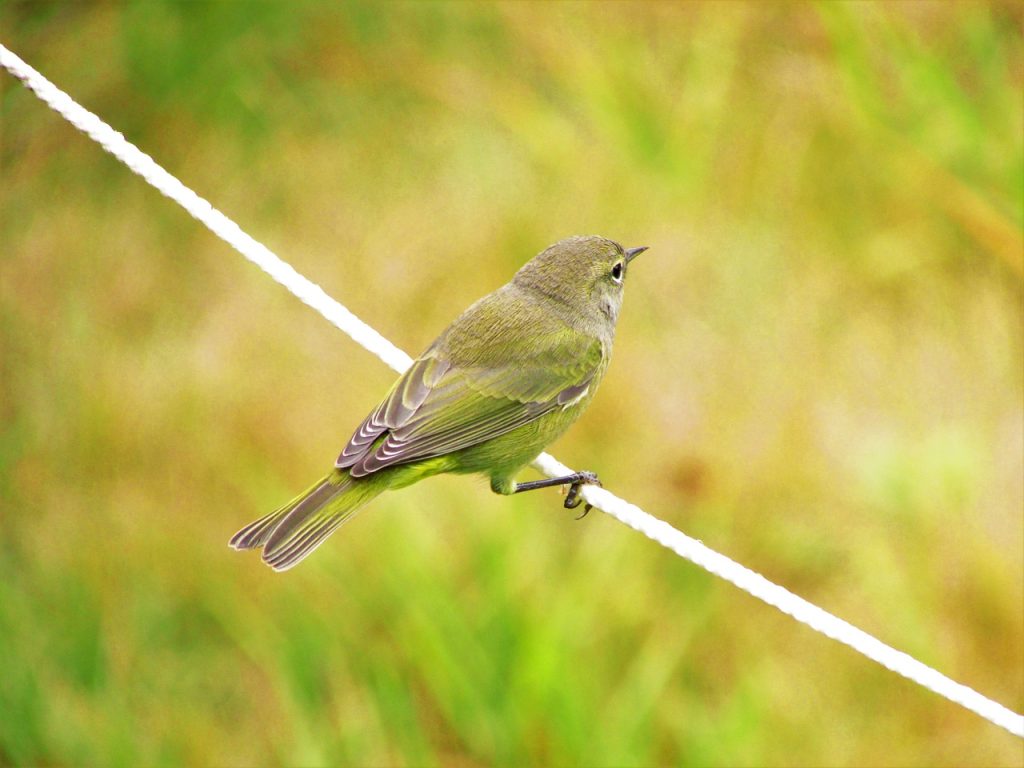
Orange-Crowned Warbler Predators and Threats
The Orange-crowned Warbler faces several natural predators in its environment, which pose threats to its survival. Here’s a closer look at the predators that may prey on Orange-crowned Warblers:
- Birds of Prey: Birds of prey such as hawks and eagles are significant predators of Orange-crowned Warblers. With their keen eyesight and powerful talons, these raptors are capable of hunting small birds like warblers, making them vulnerable to predation, especially when they are perched or in flight.
- Cats: Both domestic and wild cats are opportunistic hunters and pose a threat to Orange-crowned Warblers. Cats are skilled predators that can stalk and ambush small birds, particularly when they are foraging on the ground or nesting in low vegetation.
While these predators pose natural threats to Orange-crowned Warblers, human-induced factors such as habitat loss and climate change also contribute to their vulnerability:
- Climate Change: Heatwaves during the spring can be detrimental to Orange-crowned Warbler chicks, especially if they haven’t fledged from the nest yet. High temperatures can lead to dehydration, heat stress, and reduced food availability, impacting the survival of young birds.
- Habitat Loss: Commercial development and urbanization lead to the destruction and fragmentation of the Orange-crowned Warbler’s natural habitat. Loss of suitable breeding and foraging habitats reduces their available resources and increases their susceptibility to predation and other threats.
By understanding the predators and threats facing Orange-crowned Warblers, conservation efforts can be targeted towards mitigating these risks and ensuring the long-term survival of this species in their native habitats.
Orange-Crowned Warbler Reproduction, Babies, and Lifespan
The courtship and breeding behavior of Orange-crowned Warblers involves intricate displays and parental care. Here’s a closer look at their mating rituals and nesting habits:
- Courtship Display: When a male Orange-crowned Warbler seeks to court a female, he engages in a series of displays to attract her attention. This includes following her while drooping his wings, spreading his tail, and pointing his bill upwards. These behaviors signal his readiness to mate and demonstrate his fitness as a potential partner.
- Defense of Mate and Nest: Once a pair has formed, the male becomes protective of his mate and nest. He may display aggression towards other male Orange-crowned Warblers, especially if they attempt to interrupt the pairing process. However, other bird species are generally tolerated in the vicinity.
- Nesting and Incubation: The female Orange-crowned Warbler typically lays 3-6 eggs in her nest annually, with just one brood per year. The eggs are white or cream-colored with reddish-brown speckles, and incubation lasts for about 11-13 days. Both parents take turns incubating the eggs to ensure their proper development.
- Hatching and Parental Care: Upon hatching, the chicks are covered in dark gray down feathers and have closed eyes. Despite this, they are able to gape for food and raise their heads to receive nourishment from their parents. Both parents play active roles in feeding and caring for the young chicks until they are ready to leave the nest.
- Fledging: After about 10-13 days, the chicks are ready to leave the nest, although they may continue to improve their flight skills over time. Even after leaving the nest, the parents continue to feed and care for the fledglings for a few more days, ensuring their survival as they transition to independence.
The courtship rituals and parental care exhibited by Orange-crowned Warblers are essential for successful breeding and raising of offspring, highlighting their dedication to ensuring the survival of the next generation.
Orange-Crowned Warbler Population
The Orange-crowned Warbler’s current population estimate of approximately 76 million individuals across North, Central, and South America suggests a stable population trend, leading to its classification as “Least Concern” by the International Union for Conservation of Nature (IUCN).
However, historical data reveals a concerning decline in population numbers. From 1966 to 2014, the North American Breeding Bird Survey reported a decline of about 34% in the Orange-crowned Warbler population. This decline was primarily attributed to habitat loss and degradation, highlighting the importance of conservation efforts to protect their natural habitats.
Despite being considered “Least Concern” overall, the Orange-crowned Warbler faces ongoing threats, with global warming posing a significant risk to their population. Climate change alters migration patterns and breeding seasons, disrupting the birds’ life cycles and impacting their ability to find suitable habitats and food sources.
Additionally, anthropogenic structures such as towers and wind turbines pose risks to Orange-crowned Warblers, leading to potential collisions and mortality.
While the population is currently stable, continued monitoring and conservation efforts are essential to ensure the long-term survival of the Orange-crowned Warbler and other avian species in the face of environmental challenges. By addressing habitat loss, mitigating the impacts of climate change, and implementing measures to reduce the risk of collisions with man-made structures, we can help safeguard the future of these birds and their ecosystems.
Conclusion
The Orange-crowned Warbler is a resilient songbird with a subtle beauty and remarkable adaptability. While facing threats such as habitat loss and climate change, its stable population and conservation status as “Least Concern” underscore the importance of ongoing efforts to protect its habitats and ensure its continued survival across the Americas.
range-crowned warbler,,orange-crowned warbler male vs female,,orange-crowned warbler range,,orange-crowned warbler diet,,orange-crowned warbler habitat,,orange-crowned warbler in my backyard yesterday. — in huntington beach, california,,orange-crowned warbler juvenile,,orange-crowned warbler subspecies identification,,orange-crowned warbler audubon,,orange-crowned warbler song
